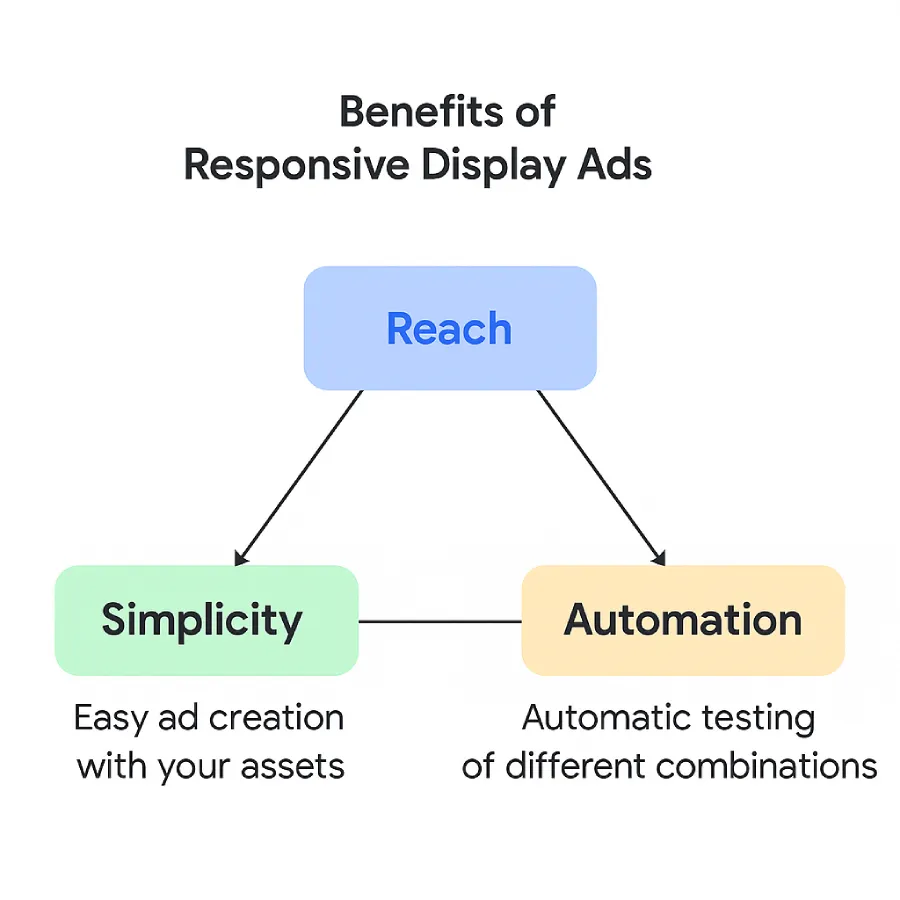I was sitting at home, halfway through my Google Ads study, when I read about Emily, a small business owner who sells handmade soap. She used Responsive Display Ads with just a few headlines and photos… and boom — her traffic tripled.
That’s when I thought, “Okay, this isn’t just for big brands. This actually works.”
Question
What’s provided by Responsive Display Ads?
- Complete creative control and reach
- Reach, simplicity, automation
- Reach, scale, control
- Complete creative control and simplicity
✅ Correct Answer:
Reach, simplicity, automation
Why This Is Correct: “Reach, Simplicity, Automation”
The correct answer is “Reach, simplicity, automation” — and honestly, it’s not just correct… it’s genius if you’re new to advertising or don’t want to waste money on expensive ad design.
Let’s break down each of the three parts and explain why Google designed Responsive Display Ads (RDAs) to work this way.
1. Reach – Show Up Almost Everywhere
What it means:
Your ad isn’t limited to just one app or website. It can show on:
- Blogs 📝
- News sites 📰
- YouTube (side placements) 🎥
- Mobile apps 📱
- Even Gmail Promotions tab 📧
Google says Responsive Display Ads can appear across over 90% of the global internet — that’s 2 million+ sites and apps.
Simple analogy:
Imagine your ad is like a sticker. Google can stick it almost anywhere online where people scroll, tap, read, or shop. That’s the power of reach.
2. Simplicity – Easy to Set Up, Even for a Kid
What it means:
You don’t need to be a graphic designer, Photoshop wizard, or ad agency.
Just upload:
- 1 or 2 images
- A few headlines (like 5 short sentences)
- Some descriptions (2-4)
- Your logo (optional)
- And your website link
Boom. You’re done.
Google builds the ads for you in all shapes and sizes — banner, square, mobile, vertical — so they fit anywhere.
It’s like giving Google a box of LEGOs and letting it build the best structure depending on the platform.
Real-world fun tip:
Most first-time users set up an RDA in under 15 minutes — seriously, that’s quicker than ordering pizza online 🍕
3. Automation – Google Tests Everything for You
What it means:
You’re not just throwing your ad into the world and hoping it works.
Google:
- Tries different combinations of your images + text
- Learns which version gets more clicks and sales
- Automatically shows the best-performing version more often
This is called machine learning, and it’s like having a mini marketing genius working for you 24/7.
Real example:
If Headline A + Image 3 performs better than Headline B + Image 1… Google figures it out and starts using the winning combo more.
You don’t have to lift a finger.

Why The Other Answers Are Incorrect
This is where Google Ads tests your logic. All the options sound good, but they don’t all describe what Responsive Display Ads (RDA) are really meant for. Let’s go one by one and break it down like a friend explaining it over a cup of coffee ☕.
❌ 1. “Complete creative control and reach”
🚫 Why it’s wrong:
- ✅ The “reach” part is correct — RDAs do offer massive reach.
- ❌ But “complete creative control”? Not at all.
🔍 What Google actually does:
- Google automatically changes the layout, font size, image placement, even the button styles based on the platform.
- You don’t get to say, “I want this headline on top and this image beside it.”
🎨 If you want that level of control (like designing your own banners pixel by pixel), you need to use Uploaded Display Ads, not Responsive Display Ads.
💬 Simple analogy:
This is like ordering a burger and expecting to pick every ingredient yourself… but the chef says, “Nah, I’ll decide what goes best together based on other customers.” That’s RDA — optimized, not customized.
❌ 2. “Reach, scale, control”
🚫 Why it’s wrong:
- ✅ RDAs definitely give you reach and scale.
- ❌ But again, “control” is the trap word here.
🔍 Control is limited in RDAs:
- You upload assets (like images, headlines, logos), and Google decides how to show them, where to place them, and which combinations perform best.
- You can’t tell Google, “Always use this image with this text in this shape ad.”
💡 Real meaning of RDA:
It’s like a playlist you give Google — it picks the top-performing songs and arranges them to fit the mood (a.k.a., ad placement).
👎 So while the answer sounds powerful and promising… it’s not accurate.
❌ 3. “Complete creative control and simplicity”
🚫 Why it’s wrong:
- ✅ Simplicity? Totally — RDAs are crazy simple to set up.
- ❌ But “complete creative control” again? Nope!
🧠 Think about it:
- If something is super simple, it usually means you’re giving up control to the system (aka Google).
- In RDAs, simplicity comes from automation — Google handles the heavy lifting.
⚠️ You can’t control:
- The ad layout
- Text wrapping
- What shows up in a banner vs sidebar
- Font type or alignment
📦 Analogy:
It’s like using Canva’s auto-template instead of designing from scratch — fast and effective, but not fully yours.
Summary Table: What’s Right vs Wrong
| Answer Choice | Reach | Simplicity | Automation | Full Control | Verdict |
|---|---|---|---|---|---|
| ✅ Reach, simplicity, automation | ✅ Yes | ✅ Yes | ✅ Yes | ❌ No | ✅ Correct |
| ❌ Complete creative control and reach | ✅ Yes | ❌ No | ❌ No | ❌ Not in RDA | ❌ Incorrect |
| ❌ Reach, scale, control | ✅ Yes | ❌ No | ✅ Yes | ❌ Not true control | ❌ Incorrect |
| ❌ Complete creative control and simplicity | ❌ Partial | ✅ Yes | ✅ Yes | ❌ No | ❌ Incorrect |
Real-Life Story: Emily’s Handmade Soap Brand

Emily runs a small handmade soap business. She wanted to advertise online but didn’t have the time or budget to hire a designer.
So she used Responsive Display Ads.
Here’s what she did:
- Uploaded 3 images of her soaps 🧼
- Wrote 5 short headlines
- Added 3 descriptions and her website link
- ✅ DONE in 15 minutes
Google did the rest:
- Placed her ads on skincare blogs
- Showed them in Gmail promotions
- Ran tests to see which headline+image combo worked best
Within 2 weeks:
- 🛒 Website visits tripled
- 💰 Sales increased by 48%
- 📉 Cost per click stayed under $0.45
Emily said:
“I didn’t even know where my ads were showing — but they were everywhere. And they worked!”
Chart: What Responsive Display Ads Provide
| Feature | ✅ Available in RDA | ❌ Not Available |
|---|---|---|
| Global Reach | ✅ Yes | |
| Simplified Setup | ✅ Yes | |
| Automated Optimization | ✅ Yes | |
| Full Design Control | ❌ No | |
| Manual Format Customization | ❌ No | |
| Static Banner Uploads | ❌ No |
🧠 TL;DR: RDA = easy + smart + everywhere, but not super customized
Helpful Resources:
- 🔗 Official Google Ads: About Responsive Display Ads
- 🔗 Think with Google – Display Ad Effectiveness
- 🔗 Google Ads Help: RDA Best Practices
- 🔗 Skillshop – Google Display Certification
- 🔗 Responsive Ads vs Uploaded Ads Comparison
- 🔗 Banner ad case studies
Conclusion: RDAs = Smart Reach with Less Hassle
Responsive Display Ads are the lazy genius of digital advertising. You don’t need Photoshop skills, a team of marketers, or a massive budget.
You give Google the tools, and it builds the house.
You get:
- Big reach 🌍
- Simplicity in setup 🧩
- Automation that works while you sleep 😴
But if you’re the type who wants every pixel in your ad to be perfect, RDAs aren’t for you.
FAQs About Responsive Display Ads (Real & Simple)
1. Do Responsive Display Ads really automate everything?
Yes! Google automatically adjusts the ad’s layout, font, color, and content placement to perform better.
2. Can I preview what the ad will look like?
Yes — Google shows previews of different layout styles when you create your ad.
3. Do RDAs run on YouTube?
They don’t show in YouTube videos like TrueView, but they can appear in YouTube sidebar placements.
4. Can I run remarketing with RDAs?
Absolutely. RDAs work great with dynamic remarketing and audience targeting.
5. What are the image size requirements?
At least one landscape (1.91:1) and one square image (1:1). Recommended resolution: 1200×628 or higher.
6. Can I control exactly how the ad looks?
No. Google optimizes and adjusts it for each website or app. If you want control, use Uploaded Display Ads.
7. Are RDAs good for beginners?
Yes! They’re perfect for new advertisers who want easy setup and strong results.
8. Can I use video in a Responsive Display Ad?
Yes! You can upload a YouTube link and Google will include it as a playable option in supported placements.
9. What’s the average CTR for Responsive Ads?
Usually around 0.3% to 1.0%, but this depends on your industry and creative quality.
10. Is it okay to just use text and skip images?
It’s better to include both. Google will generate more variations, and more variations = more performance data.
